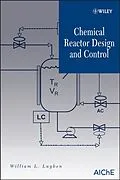Chemical Reactor Design and Control uses process simulators
like Matlab®, Aspen Plus, and Aspen Dynamics to study the
design of chemical reactors and their dynamic control. There are
numerous books that focus on steady-state reactor design. There are
no books that consider practical control systems for real
industrial reactors. This unique reference addresses the
simultaneous design and control of chemical reactors. After a
discussion of reactor basics, it:
* Covers three types of classical reactors: continuous stirred
tank (CSTR), batch, and tubular plug flow
* Emphasizes temperature control and the critical impact of
steady-state design on the dynamics and stability of reactors
* Covers chemical reactors and control problems in a plantwide
environment
* Incorporates numerous tables and shows step-by-step
calculations with equations
* Discusses how to use process simulators to address diverse
issues and types of operations
This is a practical reference for chemical engineering
professionals in the process industries, professionals who work
with chemical reactors, and students in undergraduate and graduate
reactor design, process control, and plant design courses.
Autorentext
William L. Luyben, PhD, is a Professor of Chemical Engineering at Lehigh University. In addition to teaching for forty years, Dr. Luyben spent nine years as an engineer with Exxon and DuPont. He has written nine books, including Distillation Design and Control Using Aspen Simulation (Wiley), and more than 200 papers. He was awarded the AIChE CAST Division "Computing Practice Award" in 2003 and elected to the Process Automation Hall of Fame in 2005.
Klappentext
Chemical Reactor Design and Control uses process simulators like Matlab, Aspen Plus, and Aspen Dynamics to study the design of chemical reactors and their dynamic control. There are numerous books that focus on steady-state reactor design. There are no books that consider practical control systems for real industrial reactors. This unique reference addresses the simultaneous design and control of chemical reactors. After a discussion of reactor basics, it:
- Covers three types of classical reactors: continuous stirred tank (CSTR), batch, and tubular plug flow
- Emphasizes temperature control and the critical impact of steady-state design on the dynamics and stability of reactors
- Covers chemical reactors and control problems in a plantwide environment
- Incorporates numerous tables and shows step-by-step calculations with equations
- Discusses how to use process simulators to address diverse issues and types of operations
This is a practical reference for chemical engineering professionals in the process industries, professionals who work with chemical reactors, and students in undergraduate and graduate reactor design, process control, and plant design courses.
Zusammenfassung
Chemical reactorscontrol should be considered during design
Chemical Reactor Design and Control uses process simulators like Matlab, Aspen Plus, and Aspen Dynamics to study the design of chemical reactors and their dynamic control. There are numerous books that focus on steady-state reactor design. There are no books that consider practical control systems for real industrial reactors. This unique reference addresses the simultaneous design and control of chemical reactors. After a discussion of reactor basics, it:
- Covers three types of classical reactors: continuous stirred tank (CSTR), batch, and tubular plug flow
- Emphasizes temperature control and the critical impact of steady-state design on the dynamics and stability of reactors
- Covers chemical reactors and control problems in a plantwide environment
- Incorporates numerous tables and shows step-by-step calculations with equations
- Discusses how to use process simulators to address diverse issues and types of operations
This is a practical reference for chemical engineering professionals in the process industries, professionals who work with chemical reactors, and students in undergraduate and graduate reactor design, process control, and plant design courses.
Inhalt
Preface. Chapter 1. Reactor Basics. 1.1 Fundamentals of Reaction Equilibrium and Kinetics. 1.1.1 Power-Law Kinetics. 1.1.2 Heterogeneous Reaction Kinetics. 1.1.3 Biochemical Reaction Kinetics. 1.1.4 References. 1.2 Multiple Reactions. 1.2.1 Parallel Reactions. 1.2.2 Series Reactions. 1.3 Determining Kinetic Parameters. 1.4 Types and Fundamental Properties of Reactors. 1.4.1 Continuous Stirred-Tank Reactor. 1.4.2 Batch Reactor. 1.4.3 Tubular Plug-Flow Reactor. 1.5 Heat Transfer in Reactors. 1.6 Reactor Scale-Up. 1.7 Conclusion. Chapter 2. Steady-State Design of CSTR Systems. 2.1 Irreversible, Single Reactant. 2.1.1 Jacket Cooled. 2.1.2 Internal Coil. 2.1.3 Other Issues. 2.2 Irreversible, Two Reactants. 2.2.1 Equations. 2.2.2 Design. 2.3 Reversible Exothermic. 2.4 Consecutive Reactions. 2.5 Simultaneous Reactions. 2.6 Multiple CSTR's. 2.6.1 Multiple Isothermal CSTR's in Series with Reaction A-B. 2.6.2 Multiple CSTR's in Series with Different Temperatures. 2.6.3 Multiple CSTR's in Parallel. 2.6.4 Multiple CSTR's with Reversible Exothermic Reactions. 2.7 Auto-Refrigerated Reactor. 2.8
